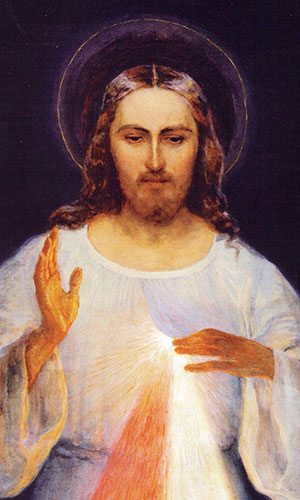 Following in the wake of Easter Sunday is Divine Mercy Sunday, which has become one of the most treasured feasts during the Easter season. This year it is celebrated on April 27.
Following in the wake of Easter Sunday is Divine Mercy Sunday, which has become one of the most treasured feasts during the Easter season. This year it is celebrated on April 27.
Mankind’s need for the message of Divine Mercy took on dire urgency in the 20th century, when civilization began to experience an “eclipse of the sense of God” and, therefore to lose the understanding of the sanctity and inherent dignity of human life. In the 1930s, Jesus chose a humble Polish nun, St. Maria Faustina Kowalska, to receive private revelations concerning Divine Mercy that were recorded in her Diary. St. John Paul II explains: “This was precisely the time when those ideologies of evil, nazism and communism, were taking shape.
Sister Faustina became the herald of the one message capable of off-setting the evil of those ideologies, that fact that God is mercy – the truth of the merciful Christ. And for this reason, when I was called to the See of Peter, I felt impelled to pass on those experiences of a fellow Pole that deserve a place in the treasury of the universal Church” St. John Paul II, “Memory and Identity” (2005).
In his second encyclical, “Rich in Mercy,” St. John Paul II offered an extended meditation on the mystery of God’s mercy, which he calls “the greatest of the attributes and perfections of God.” He returned to this theme throughout his pontificate.
On May 5, 2000, five days after the canonization of St. Faustina, the Vatican decreed that the Second Sunday of Easter would henceforth be known as Divine Mercy Sunday.
The devotion to Divine Mercy Sunday grew rapidly after its designation by the pope and is now widely celebrated by Catholics. The Divine Mercy image is often carried in processions on Divine Mercy Sunday, and is placed in a location in the church so that it can be venerated by those who attend the Mass
John Paul II, who died in April 2005 on the vigil of Divine Mercy Sunday, was himself beatified on Divine Mercy Sunday, May 1, 2011, by his successor, Pope Benedict XVI, and was canonized on Divine Mercy Sunday, April 27, 2014, by Pope Francis.
— USCCB
How to pray the Divine Mercy Chaplet
The Chaplet of Divine Mercy was given to St. Faustina with this promise: “Encourage souls to say the chaplet which I have given you” (Diary, 1541). “Whoever will recite it will receive great mercy at the hour of death. … Even if there were a sinner most hardened, if he were to recite this chaplet only once, he would receive grace from My infinite mercy. I desire that the whole world know My infinite mercy” (Diary, 687). The Divine Mercy Chaplet is prayed using a rosary:
Step 1: Begin with the Sign of the Cross, then say one Our Father, one Hail Mary and the Apostles Creed. An optional opening prayer is: “You expired, Jesus, but the source of life gushed forth for souls, and the ocean of mercy opened up for the whole world. O Fount of Life, unfathomable Divine Mercy, envelop the whole world and empty Yourself out upon us.” Then repeat three times: “O Blood and Water, which gushed forth from the Heart of Jesus as a fountain of Mercy for us, I trust in You!”
Step 2: Then on the beads where with the rosary you would pray an Our Father, say the following: “Eternal Father, I offer You the Body and Blood, Soul and Divinity of Your dearly beloved Son, Our Lord Jesus Christ, in atonement for our sins and those of the whole world.”
Step 3: On each of the 10 Hail Mary beads, say the following: “For the sake of His sorrowful Passion, have mercy on us and on the whole world.”
Repeat steps 2 and 3 for all five decades.
Step 4: Conclude by saying the following three times: “Holy God, Holy Mighty One, Holy Immortal One, have mercy on us and on the whole world.” An optional closing prayer is: “Eternal God, in whom mercy is endless and the treasury of compassion inexhaustible, look kindly upon us and increase Your mercy in us, that in difficult moments we might not despair nor become despondent, but with great confidence submit ourselves to Your holy will, which is Love and Mercy itself.”


